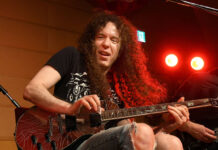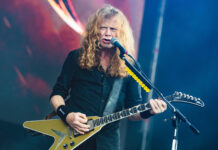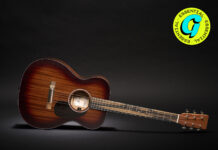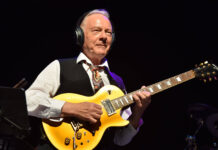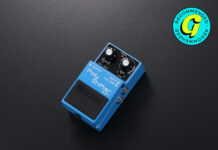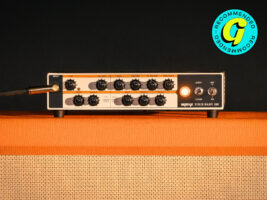
Orange Tour Baby 100 review: the best argument for a loud solid-state head?
When people talk about ditching tubes from their rigs in 2025, that normally means grabbing a digital modeller and going direct. This makes sense, really. Modeling sounds better than ever, and you can fit a Quad Cortex in a backpack. Tube heads are large, heavy and expensive to maintain – especially if you gig a lot. But what if you want to ditch tubes but don’t want to go digital? What if you want to keep your analogue pedalboard and your stage volume, but save on weight and tube amp maintenance?
READ MORE: Boss Katana-Mini X review – the ultimate portable practice amp?
It’s an appealing prospect – and Orange has the latest solution if you’re in this particular boat, with the expanded Baby series (yes, weird name). Three amps have followed the deliberately dull, clean 100-watt power amp that was the Pedal Baby – there’s now the Dual Baby (with a clean/overdrive channel and a high-gain channel), the Gain Baby (with a clean channel and a high-gain channel) and, on the review bench today, the Tour Baby (with a clean channel and an overdriven channel).
It’s important to note that Orange has not invented a totally new style of amp here. Bassists are rolling their eyes right now, because this is half the bass amp market, and on the guitar side, there are some (but not many) other brands doing a similar thing. Most notable is probably Quilter, which has gained a good reputation for its compact, tourable and loud analogue solid state heads. I’ve seen US bands that are known amplifier nerds tour the UK with Quilters because, well, they sound great and are just easier to move around than 100-watt tube heads.
So Orange doing amps like these makes total sense – the brand has proved it’s a dab-hand at making analogue solid-state heads sound great (see the reputation the Super Crush 100 has gained amongst people who are normally tube purists) – and the Pedal Baby was a reliable and very useful piece of kit. It’s also a natural evolution of the mini-lunchboxes like the Tiny Terror and Micro Dark, albeit with a hefty bump in the output power. Could these new Baby amps help you downsize your rig?
Image: Press
Through some strange providence, our Tour Baby review unit arrives very shortly after I purchased myself a Super Crush 100. This is a fairly useful counterpoint for the Tour Baby – both amps have the same power stage, the 100-watt Class A/B power amp found in the Pedal Baby – and both amps feature circuits that are effectively standard valve amp preamps with JFETs in place of vacuum tubes.
The Super Crush is aiming for more than just sound, though – it is also about vibe, given that it’s encased in that orange-tolex’d wooden headshell, and is almost the same size as a Rockerverb 100. The Tour Baby, meanwhile, is bare metal all around – and compact enough to look somewhat goofy atop a 4×12. But perhaps more importantly it’s a comfortable one-handed lift, and comes with a sturdy, high-quality gigbag. You can also grab a cheap kit to mount it into a rack case – meaning you can either integrate it into a larger do-it-all tour rack, or have it live within a 2U rack hardcase for extra protection.
Given the touring realities of 2025, being able to realistically walk from the car into the venue with a guitar on your back, a pedalboard in one hand and a whole 100-watt amplifier in the other is a pretty appealing prospect. And there’s not really that much compromise in the utility features given the size of the thing – there’s still an effects loop, the channels are footswitchable, and there’s also a secondary volume control on the drive channel for a reliable solo boost.
Image: Press
Does the Orange Tour Baby 100 sound good?
Now, I am fully aware that I have kind of always been a fan of Orange’s thing – I’ve been gigging an OR15 for years, and a lot of the sounds I tend towards are explicitly designed to work with an Orange’s crunchy, midrange-forward voicing. So there may be some part of my brain that just clicks with whatever comes out of an Orange amp.
Biases acknowledged – I am a huge fan of how the Tour Baby sounds. The gain channel is crunchy, loud, responsive and at no point is it distractingly solid-state. Perhaps most importantly, it sounds like an Orange amp. Clearly the lessons Orange learnt in making the Super Crush 100 sound so convincingly tube-y have been applied here, there’s all of the vocal quality in the midrange and the unrestrained hairiness in the overdrive that gives an Orange amp its character.
Like the Super Crush, the Tour Baby’s maximum gain setting is actually quite a bit below total saturation – there’s the Gain Baby (no, that name isn’t getting any less weird) for that – the benefit of the Tour Baby’s crunchier, slighter lower gain and higher headroom approach is that it is an excellent pairing with fuzz and drive pedals. Both a Green Russian Big Muff and a RAT do what you’d expect when running into the dirt channel of the Tour Baby: they bring their own character of dirt to the party while also driving the front end into satisfying, collapsing saturation.
Image: Press
Basically every fuzz pedal I put in front of this thing was an absolute joy to play. Things compress and cave in a really pleasing way, and for my money that’s the aspect of a tube-driven amp that’s important to capture if you’re an Orange. It’s really easy to dial in everything from razor-sharp tight chugs to towering walls of doom with just a single drive pedal – and thanks to the presence control, any solid-state fizz that does appear is quickly dialled out.
Moving onto the clean channel – without the compressor engaged, it’s dry as a bone, with only a very basic two-band EQ to differentiate it from plugging into the effects return. There is basically endless headroom here, so if your entire sound is your pedalboard, this is where you’ll want to be.
For a more interesting clean sound, I engage that VCA compressor – it’s interesting to see that included here, as it’s obviously more of a common inclusion on bass amps. But it makes total sense; how often is the answer to “how do I make my clean sound less boring?” basically just “get a compressor pedal”?
The compressor sounds very on when engaged, with lots of squish and recovery – as good at accentuating funky, fast-picked stuff as it is for adding interest to more spacious playing. It’s also handy for when you switch channels, as it keeps the general level of sustain at least similar – rather than having it fall completely off a cliff upon going clean.
The only thing that’s missing, really, is any on-board reverb, which the Super Crush 100 does have. I’m aware that I’m asking a lot to be packed into such a small amplifier, but for some players just a touch of reverb is all they need from the time-based department – so having on-board reverb could mean having to run cables to the effects loop, and find a reverb pedal you like.
Image: Press
Who is the Tour Baby for?
The Tour Baby is refreshingly unapologetic about being made to be gigged often, loud and hard. It goes beyond its supremely chuckable size – the option for footswitchable channel switching and a master volume boost will doubtless be useful for many, and that in-built compressor could kick that beaten-up dyna-comp off your board if you were just using it for cleans.
The included gigbag is great, too – it probably wouldn’t help you if the thing fell out of the car on the motorway, but it provides good protection for the front panel and lets you carry the amp, the power lead and a speaker cable all in one hand. If you play small-to-medium gigs on the regular, the portability, pedal-friendliness, range of volume and overall rugged, no-nonsense approach should all speak for themselves.
If you’re after a home amplifier, however, this is likely not it. One result of its gig-forward approach is that there’s no master volume, just the channel volumes. This is at most a mild annoyance on stage – but at home, it makes it very tricky to get a reasonable volume going. From 1.5 and 1.6 on the dial the channel volumes go from whisper-quiet to eardrum-blasting. In a pinch you could improvise a master volume by putting something like the JHS Little Black Box (or DIY equivalent) into the effects loop if you needed to – but hey, at the end of the day this is a 100-watt amp with the word “tour” in its name.
The direct output doesn’t have the analogue cabinet simulation that the Super Crush’s does. On paper this is inconvenient, as it means to get a good direct sound you’ll have to run the amp into some sort of cabinet sim. In reality, however, this is great news – that analogue cab sim from the Super Crush 100 is basically the only part of that amp that’s unequivocally bad, and it couldn’t be turned off. So while the lack of a master volume might complicate your efforts to play the amp at home, you can always run the direct out into either an audio interface or a hardware cabinet sim if you do want to use it as more of a desktop amp.
It is also worth noting just how affordable the Tour Baby is, too – £459 is not really that much money given how much the thing can do. The original Pedal Baby was a great piece of kit, but it was hard to get too excited about it – whatever you put into it, it made it very loud. Not that exciting. But the Tour Baby’s breadth of sounds and ability to basically just slot into your rig in place of a ‘full’ amplifier? That’s a lot more intriguing.
Tour Baby 100 alternatives
Of course, there are the two other amps in the new Baby range if the Tour Baby preamp configuration doesn’t appeal. There’s also the standard Pedal Baby ($439/£279) if you already have your preamp covered with something like a UAFX amp pedal or analogue preamp. If you like Orange’s whole approach, are less worried about space and want something in the same tonal ballpark as the Baby range, the Super Crush will get you there.
If you fancy something a little different, tonally, Quilter’s amp range is a little pricier – but amps like the Tone Block 202 ($719) and OverDrive 202 ($699) are very well-regarded and just as portable as the Tour Baby. And if you want to keep it all on the board, there are options like the Seymour Duncan PowerStage ($399/£399) for clean, pedalboard power amp, or Blackstar’s Amped range (from $520/£399) for more of an “amp head on the floor” approach.
The post Orange Tour Baby 100 review: the best argument for a loud solid-state head? appeared first on Guitar.com | All Things Guitar.
Source: www.guitar-bass.net


